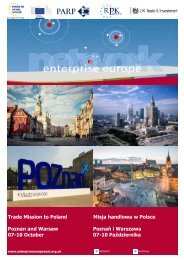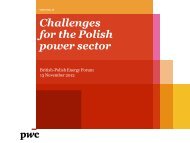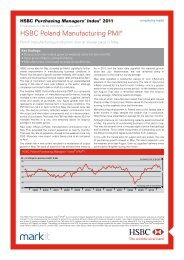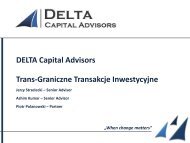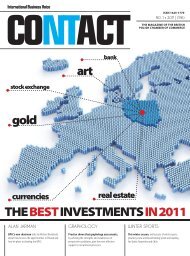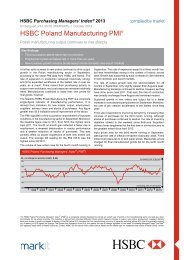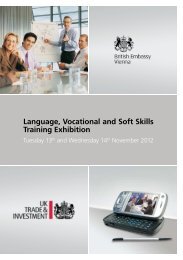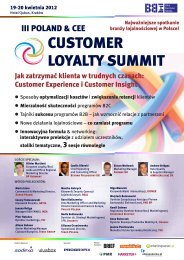to download the British Council case study presentation.
to download the British Council case study presentation.
to download the British Council case study presentation.
You also want an ePaper? Increase the reach of your titles
YUMPU automatically turns print PDFs into web optimized ePapers that Google loves.
Equal opportunities and diversity as a basisfor work-life balance – how <strong>to</strong> avoidexclusivity trapWarsaw, 28 may 2013Ewa KownackaExpert of Diversity Assesment Framework<strong>British</strong> <strong>Council</strong>
BRITISH COUNCILThe <strong>British</strong> <strong>Council</strong> creates international opportunities for <strong>the</strong> people of <strong>the</strong> UKand o<strong>the</strong>r countries and builds trust between <strong>the</strong>m worldwide. We call this workcultural relations.Over 110 countries, 8 regionsFunding: government grant (28%), earned income (English and Examinations)and managing contractsAround 7,000 staff – 6,000 locally contracted3 core areas of work of work –Arts, Education and Society and EnglishPurpose - <strong>to</strong> create international opportunities for <strong>the</strong> people of <strong>the</strong> UK and o<strong>the</strong>rcountries and build trust between <strong>the</strong>m worldwide.
PURPOSEPresentation of <strong>to</strong>ols andinitiatives used for promotingequal opportunities anddiversity management.w<strong>British</strong> <strong>Council</strong>.
What is my passion?What makes me happy?What is important for me?
Work-life balance• Declarations – practice – atmosphere• Person and his/her life as a value itself• Work as one of spheres of life• Equivalence of life spheres• Equivalence of lifestyles• Complementarity of life spheres (e.g. skills, experience,energy)
Key termsequal opportunitiesdiversity
How we understand qual opportunitiesEqual opportunity - focused on legislating againstunjustified discrimination and fair treatment of specificgroupsThe equal opportunity agenda aims <strong>to</strong> treat peoplefairly, <strong>to</strong> remove barriers <strong>to</strong> this and <strong>to</strong> redressexisting imbalances, so that groups which continue <strong>to</strong>be disadvantaged gain access <strong>to</strong> opportunities for fullparticipation in <strong>the</strong> workplace and wider society.The intention is <strong>to</strong> remove <strong>the</strong> barriers that limitwhat people can do and can be so that all peoplecan flourish, living <strong>the</strong> way <strong>the</strong>y value and wouldchoose <strong>to</strong>.
Diversity of my team• How people in my team are different?• Which of <strong>the</strong>se differences are visible and which aren’t? \• Which of <strong>the</strong>se differences can cause inequalities? In what way?• How can I introduce equal opportunities in my team?
Our valuesProfessionalismValuing peopleCreativityIntegrityMutuality
Perspektywa <strong>British</strong> <strong>Council</strong>disabilitywork-lifebalancebusinesssexualidentityArts andcultureEducationand societyagemorallegalGenderEnglishethnicityreligion orbeliefSupportingInclusionandHumanRightsA processnot aneventAligned <strong>to</strong>our valuesAchievingimpact for<strong>the</strong> UK
Our diversity strategy• Fostering inclusion• Growing leadership and capability• Performance, impact and legal compliance
DIVERSITY STRATEGYFostering inclusionMaking organisation a plce in whichemployees are are treated with respect andcan be <strong>the</strong>mselves, without beingdiscriminated.
DIVERSITY STRATEGYGrowing leadershipand capabilitySupporting employees, especially on leadership positions, inachieving better understanding of equal opportunities and diversity.This can be achieved by developing <strong>the</strong>ir skills and knowledge andby general support in achieving better self-assurance and skills in<strong>the</strong> EO&D agenda.
DIVERSITY STRATEGYPerformance, impactand legal complianceFinding appropriate <strong>to</strong>ols for measuring our work in <strong>the</strong>EO&D agenda and making sure that our actions bringeffects.
Staff trainingThe EOD Resources <strong>to</strong>olkit – <strong>to</strong>ols for organisingtraining sessions regarding different EO&D aspectsTraining sessions in different officesManda<strong>to</strong>ry EO&D online training and EO&D elementsin recruitment and HR management courses.
Measuring performance and impactEquality moni<strong>to</strong>ring• employmentEquality Impact Assessment• activitiesEO&D Index• Employees’ surveyDiversity Assessment Framework• multi-level assessment
Equality moni<strong>to</strong>ringSince 2001In <strong>the</strong> United KingdomAnonimous data ga<strong>the</strong>ringExternal expert, June Jackson from <strong>the</strong> Equality Research and ConsultingLtd (Royal Holloway Enterprise, University of London)Detailed report about <strong>the</strong> institution, taking in<strong>to</strong> account employment bygender, age, disability, ethnicity, depentants, reduced hours/part-time,religion or belief, sexual orientationComments and recommendations for people responsible for management
Equality Impact Assessment (EIA)Need <strong>to</strong> ensure policies, functions and practices do not unjustifiablydiscriminate / have adverse impact on equality groupsOpportunity <strong>to</strong> promote equality, good relations and inclusionImpact assessed in relation <strong>to</strong> nine equality categories (age, disability,ethnicity/race, gender including transgender, marital status,religion/belief, sexual orientation, dependant responsibilities, politicalopinion)
EO&D Index
DAF – Diversity Assessment Framework• 5 level cumulative framework that feeds in<strong>to</strong> scorecard• 2007/08 – 86% of countries, all scored level 1Level 1:EmbarkingLevel 2:ProgressingLevel 3:PerformingLevel 4:MainstreamingLevel 5:Leading• There is basicevidence ofEO&Dperformance• There isadequateevidence ofEO&Dperformance• There is strongevidence ofEO&Dperformance• There issubstantialevidence ofEO&Dperformance• There iscomprehensiveevidence ofEO&Dperformancethat is seeninternally andexternally asexemplary
DAF – who is responsible for what?Every employeeAll employees–provideevidenceLocalCoordina<strong>to</strong>r –coordinatesand explainsRegionalCoordina<strong>to</strong>radvisesIn-CountrySelf-AssessmentPanel – helpsin choosing <strong>the</strong>best evidence
The DAF and its playersReport <strong>to</strong> Martin DavidsonFeedback <strong>to</strong> Regional andCountry Direc<strong>to</strong>rsFeedback <strong>to</strong> regional GDNrepresentatives<strong>British</strong> <strong>Council</strong> Annual ReportDiversity UnitLeads <strong>the</strong> DAF process. Collates moderatedcountry scores and calculates regionalaverage and overall organisational result.Prepares final reports for individual countriesand drafts final DAF report.Moderation PanelCentral panel moderates all submissions <strong>to</strong> ensure rigour, integrity andconsistencyIn-Country Self-Assessment PanelsLed by DAF co-ordina<strong>to</strong>r, a panel of at least 3 members, including one external contact(not a BC employee), reviews <strong>the</strong> evidence and on <strong>the</strong> basis of <strong>the</strong> communicatedscoring system assigns a level indicating <strong>the</strong> performance of <strong>the</strong> countryDAF intranet site provides guidance notes, FAQs and exemplary evidence fromprevious years <strong>to</strong> best equip colleagues in understanding <strong>the</strong> requirements of <strong>the</strong>processBriefs & managesAdvises directly & via GDNInforms and maintains
ScoringN/D0123A small number of indica<strong>to</strong>rs may not be applicable <strong>to</strong> somecountries. Guidance on which indica<strong>to</strong>rs may be non-applicable<strong>to</strong> you is detailed in <strong>the</strong> guidance notes for <strong>the</strong> individualindica<strong>to</strong>rs.No relevant evidence provided, no valid example given and noclear explanation of how <strong>the</strong> indica<strong>to</strong>r has been met.No relevant evidence provided but valid example or explanationgiven clearly indicating how <strong>the</strong> indica<strong>to</strong>r has been addressed.Explanation and supporting evidence provided which addresses<strong>the</strong> indica<strong>to</strong>r in accordance with <strong>the</strong> guidance notes, but doesnot go beyond <strong>the</strong> minimum.Explanation and evidence beyond <strong>the</strong> minimum which clearlyfulfils <strong>the</strong> indica<strong>to</strong>r in accordance with <strong>the</strong> guidance notes.
Diversity Assessment Framework• www.britishcouncil.org/daf_book.pdf• www.britishcouncil.org/home-diversity-articles.htm
Workplace characteristicsHow can we signal our commitment <strong>to</strong> EO&D in <strong>the</strong> workplace?How can we make it visible?• Items that we use• Our personal space (desks, offices)• In mutual space (meeting rooms etc.)• In space visible/accesible <strong>to</strong> public (conference rooms,reception)
Promoting work-life balance• How can we promote work-life balance?• How can we promote different lifestyles and balancebetween <strong>the</strong>m and our work?
Guidance and supportGuidance for <strong>the</strong>self-assessmentprocessGuidance forcompiling yoursubmissionFAQsDetailedsupportingevidence foreach indica<strong>to</strong>r
Would you like <strong>to</strong> learn about diversity management? Does your organisation have<strong>to</strong>ols <strong>to</strong> support equal opportunities?Our work is about relations with people from different backgrounds and cultures.Managing diversity effectively and promoting equal opportunities is crucial for us. Wewant <strong>to</strong> share our knowledge and experience and that is why we offer you a training inmanaging diversity and promotion of equal opportunities for companies, organisationsand individuals.Training programme is based on <strong>British</strong> <strong>Council</strong>’s international experience and consistsof <strong>to</strong>pics listed below:- Organisational values and <strong>the</strong>ir role in diversity management- Strategy of diversity management- Mainstreaming and moni<strong>to</strong>ring progress- Equality moni<strong>to</strong>ring- System of staff development
Ewelina Piorunewelinapiorun@britishcouncil.plEwa Puzdrowskaewa.puzdrowska@britishcouncil.plPrzemysław Tymińskiprzemyslaw.tyminski@britishcouncil.plKarolina Szlasakarolina.szlasa@britishcouncil.pl



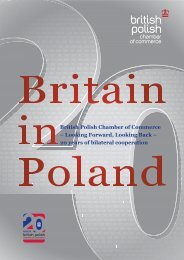

![[the zone of great potential] - KSSE](https://img.yumpu.com/43384797/1/190x134/the-zone-of-great-potential-ksse.jpg?quality=85)
